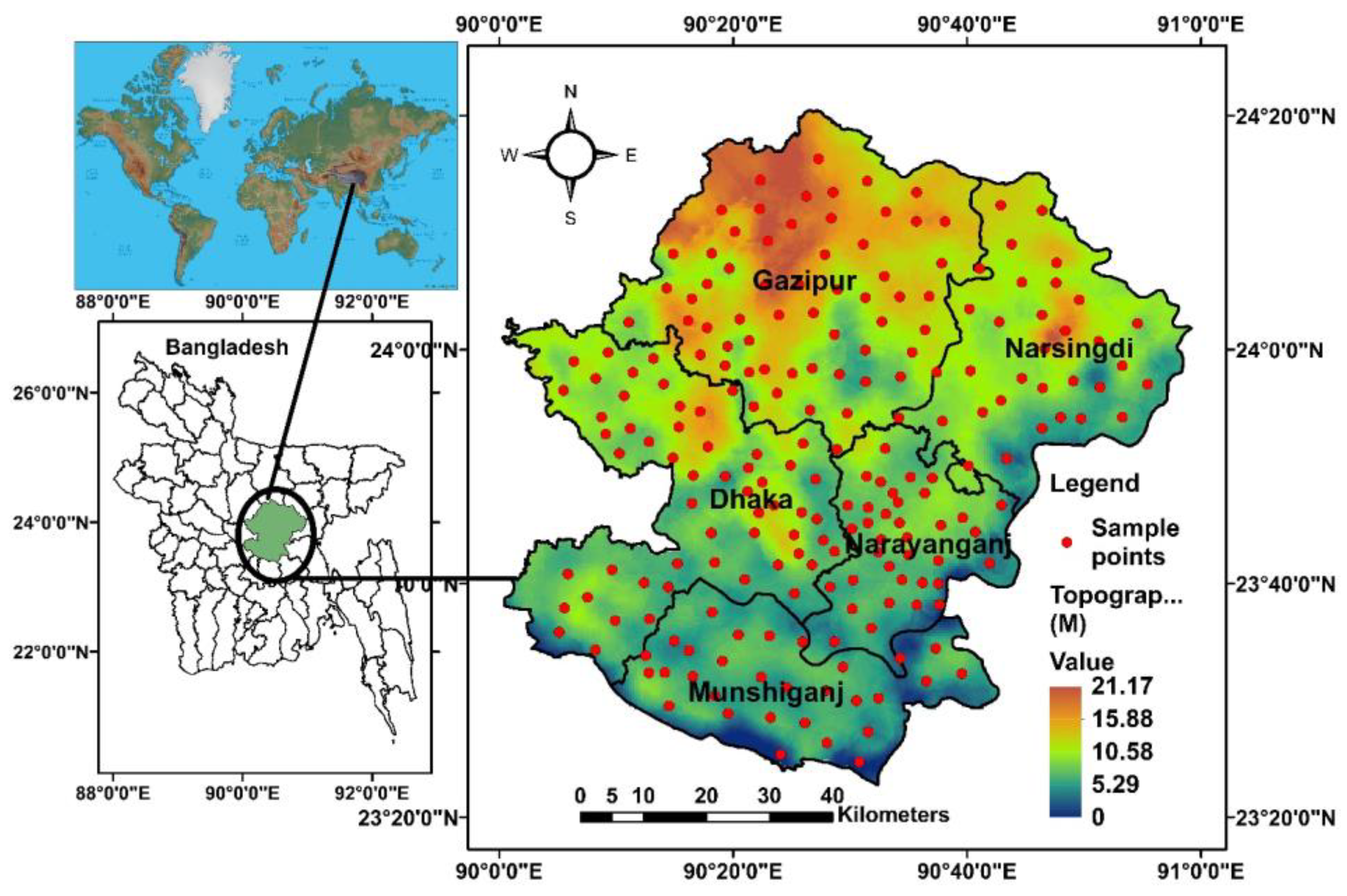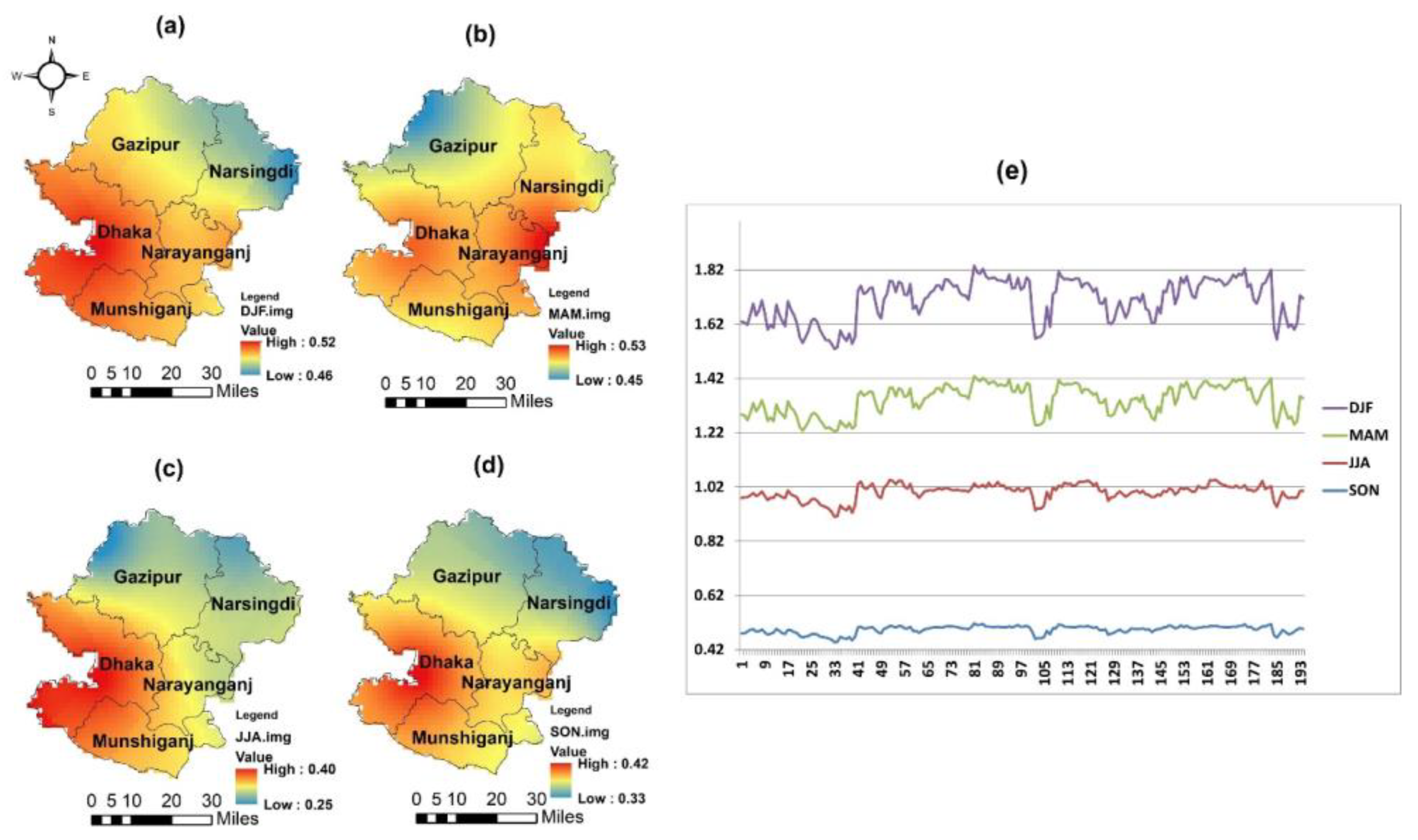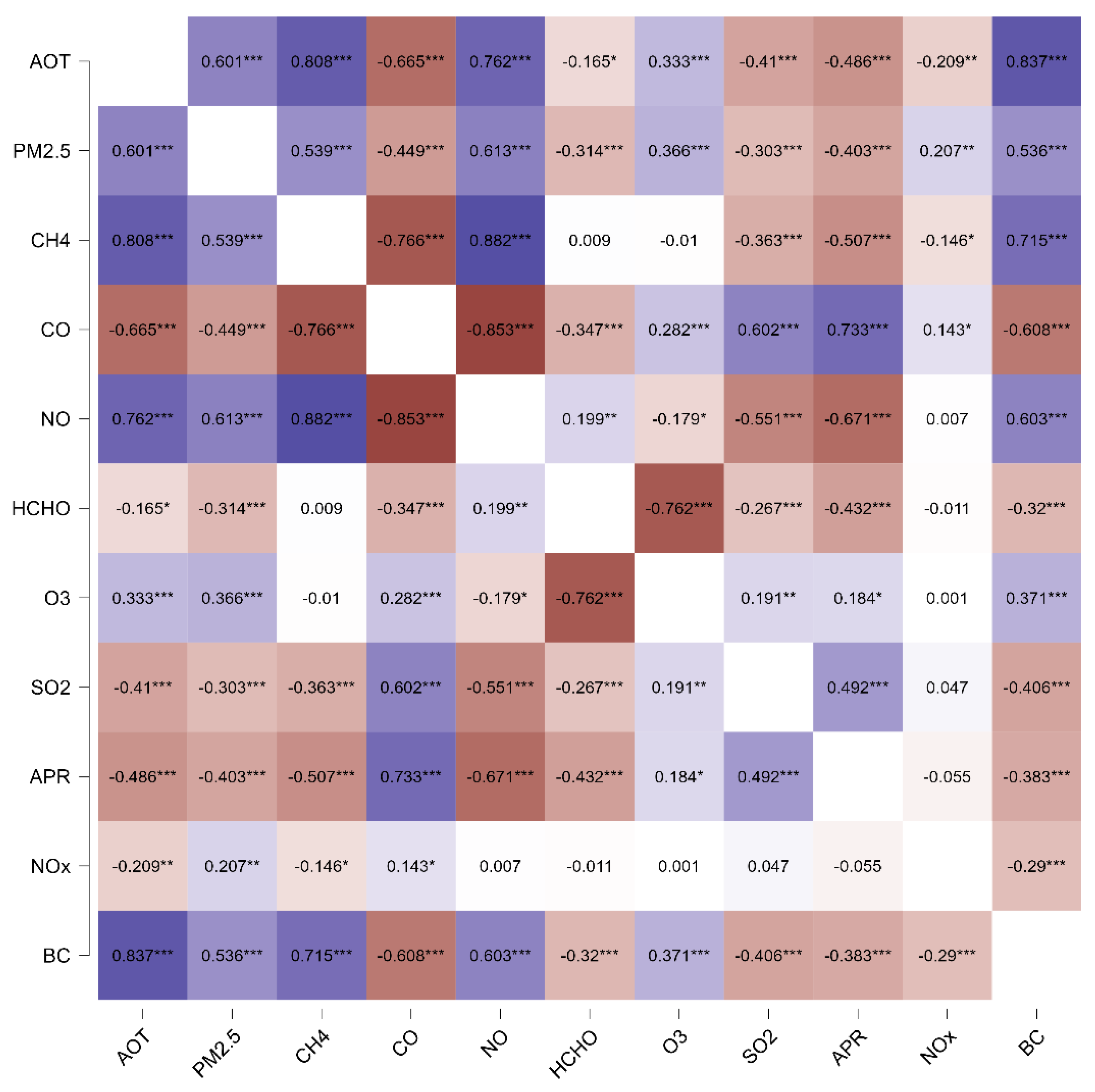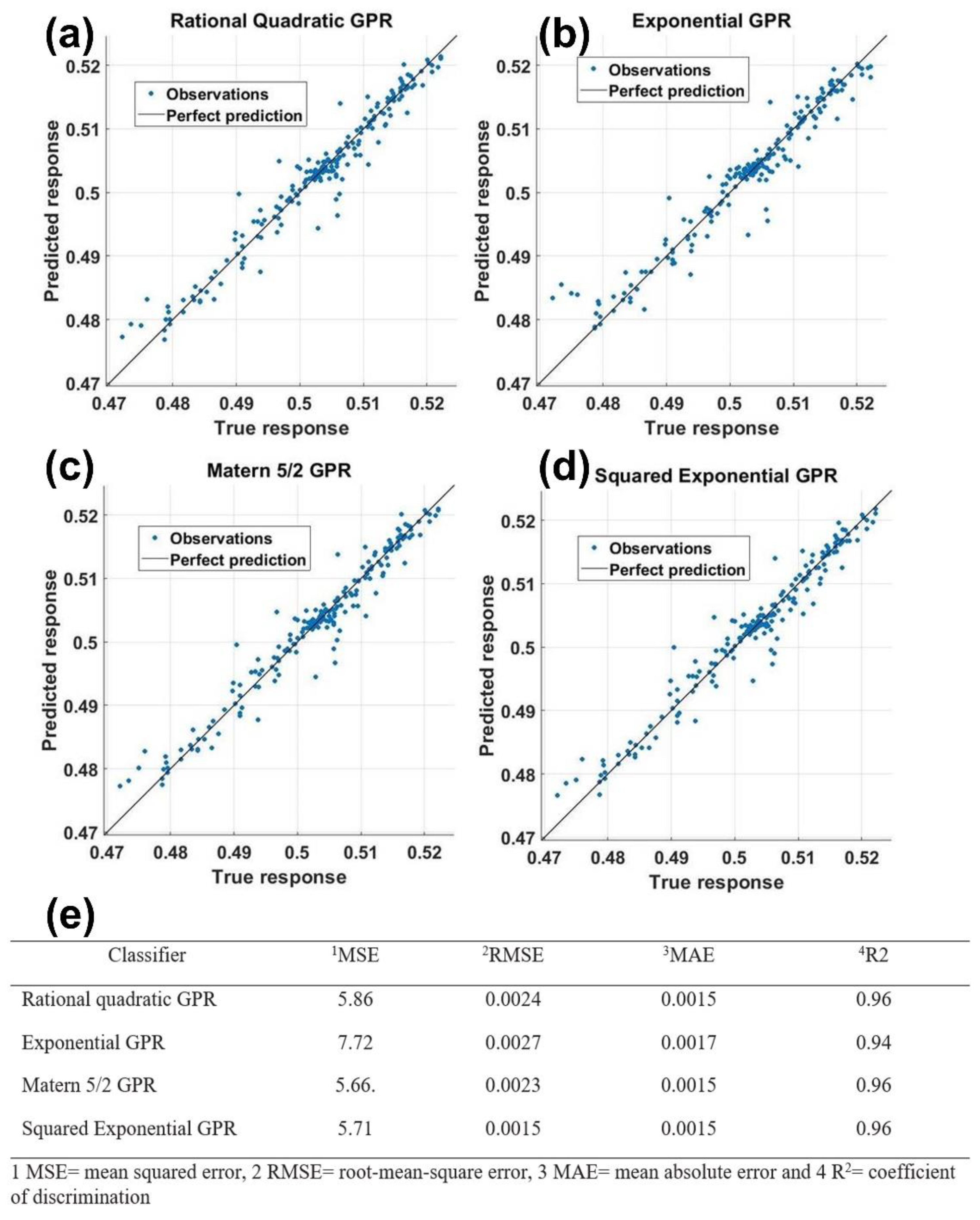Submitted:
15 March 2023
Posted:
15 March 2023
You are already at the latest version
Abstract

Keywords:
1. Introduction
2. Materials and Methods
2.1. Study Location
2.2. Datasets Used
2.3. Sample Collection
2.4. Pre-processing
2.5. Seasonal Analysis
2.6. Correlation Analysis
2.7. Point Interpolation
2.8. Machine Learning (ML) for Prediction
3. Results and Discussion
3.1. Descriptive Statistics of All Parameters
3.2. Seasonal Analysis of AOT
3.3. Correlation Analysis among Parameters
3.4. Machine Learning for Predictive Analysis
4. Conclusions
- The mean concentrations were higher in CO (82.11), PM2.5 (65.29), NO (56.15), and O3 (23.28).
- The most AOT concentrated areas were found in the central, western, and southern parts of Dhaka, Narayanganj, and Munshiganj districts.
- The concentrations of AOT were higher in December-January-February (.50) and March-April-May (0.50), while it was a bit less in June-July-August (0.33) and September-October-November (0.37).
- The AOT was correlated positively with PM2.5 (0.60), CH4 (0.80), NO (0.76), and BC (0.83), while correlated negatively with CO (-0.66), HCHO (-0.16), SO2 (-0.41), APR (-0.48), and NOx (-0.20).
- In machine learning, the Rational quadratic GPR (RMSE-0.0024, MAE-0.0015, R2-0.96%), Matern 5/2 GPR (RMSE-0.0023, MAE-0.0015, R2-0.96%), and Squared Exponential GPR (RMSE-0.0015, MAE-0.0015, R2-0.96%) were found good prediction with the AOT.
Author Contributions
Funding
Institutional Review Board Statement
Informed Consent Statement
Data Availability Statement
Acknowledgments
Conflicts of Interest
References
- Shen, Y.; Zhang, L.; Fang, X.; Zhao, Z.; Li, X.; Wang, J.; Chai, Q. Long-Term Analysis of Aerosol Optical Depth over the Huaihai Economic Region (HER): Possible Causes and Implications. Atmosphere (Basel). 2018, 9, 1–20. [Google Scholar] [CrossRef]
- Bhattarai, B. C.; Burkhart, J. F.; Stordal, F.; Xu, C. Y. Aerosol Optical Depth over the Nepalese Cryosphere Derived from an Empirical Model. Front. Earth Sci. 2019, 7, 1–17. [Google Scholar] [CrossRef]
- Plakhina, I. N.; Pankratova, N. V. Temporal Variability of Atmospheric Aerosol Optical Depth over European Territory of Russia According to Data of the Ground-Based and Satellite Observations: Tendency of Aerosol “Enlightenment”. IOP Conf. Ser. Earth Environ. Sci. 2019, 231. [Google Scholar] [CrossRef]
- Nakata, M.; Ohshima, T.; Fujito, T.; Sano, I.; Mukai, S. Relationship between Aerosol Characteristics and Altitude Based on Multi-Measurements and Model Simulations. Remote Sens. Atmos. Clouds III 2010, 7859, 78590D. [Google Scholar] [CrossRef]
- Just, A. C.; De Carli, M. M.; Shtein, A.; Dorman, M.; Lyapustin, A.; Kloog, I. Correcting Measurement Error in Satellite Aerosol Optical Depth with Machine Learning for Modeling PM2.5 in the Northeastern USA. Remote Sens. 2018, 10. [Google Scholar] [CrossRef] [PubMed]
- Tang, Y.; Xu, R.; Xie, M.; Wang, Y.; Li, J.; Zhou, Y. Spatiotemporal Evolution and Prediction of AOT in Coal Resource Cities: A Case Study of Shanxi Province, China. Sustain. 2022, 14. [Google Scholar] [CrossRef]
- Li, L.; Che, H.; Derimian, Y.; Dubovik, O.; Luan, Q.; Li, Q.; Huang, X.; Zhao, H.; Gui, K.; Zheng, Y.; An, L.; Sun, T.; Liang, Y. Climatology of Fine and Coarse Mode Aerosol Optical Thickness Over East and South Asia Derived From POLDER/PARASOL Satellite. J. Geophys. Res. Atmos. 2020, 125, 0–3. [Google Scholar] [CrossRef]
- Acharya, P.; Sreekesh, S. Seasonal Variability in Aerosol Optical Depth over India: A Spatio-Temporal Analysis Using the MODIS Aerosol Product. Int. J. Remote Sens. 2013, 34, 4832–4849. [Google Scholar] [CrossRef]
- Mamun, M. I. The Seasonal Variability of Aerosol Optical Depth over Bangladesh Based on Satellite Data and HYSPLIT Model. Am. J. Remote Sens. 2014, 2, 20. [Google Scholar] [CrossRef]
- Hasan, R.; Hiya, H. J.; Marzia, S. Atmospheric Content of Particulate Matter PM2.5 in Gazipur and Mymensingh City Corporation Area of Bangladesh. Int. J. Res. Environ. Sci. 2020, 6. [Google Scholar] [CrossRef]
- Tusher, T. R.; Ashraf, Z.; Akter, S. Health Effects of Brick Kiln Operations: A Study on Largest Brick Kiln Cluster in Bangladesh. South East Asia J. Public Heal. 2019, 8, 32–36. [Google Scholar] [CrossRef]
- Kayes, I.; Shahriar, S. A.; Hasan, K.; Akhter, M.; Kabir, M. M.; Salam, M. A. The Relationships between Meteorological Parameters and Air Pollutants in an Urban Environment. Glob. J. Environ. Sci. Manag. 2019, 5, 265–278. [Google Scholar] [CrossRef]
- Rana, M. M.; Khan, M. H. Trend Characteristics of Atmospheric Particulate Matters in Major Urban Areas of Bangladesh. Asian J. Atmos. Environ. 2020, 14, 47–61. [Google Scholar] [CrossRef]
- Hassan, M. M.; Juhász, L.; Southworth, J. Mapping Time-Space Brickfield Development Dynamics in Peri-Urban Area of Dhaka, Bangladesh Mohammad. Int. J. Geo-Information 2019, 8, 1–27. [Google Scholar] [CrossRef]
- Rahman, M. S.; Kumar, P.; Ullah, M.; Jolly, Y. N.; Akhter, S.; Kabir, J.; Begum, B. A.; Salam, A. Elemental Analysis in Surface Soil and Dust of Roadside Academic Institutions in Dhaka City, Bangladesh and Their Impact on Human Health. Environ. Chem. Ecotoxicol. 2021, 3, 197–208. [Google Scholar] [CrossRef]
- Nayeem, R. A. A.; Hossain, M. S.; Majumder, A. K. PM2.5 Concentration and Meteorological Characteristics in Dhaka, Bangladesh. Bangladesh J. Sci. Ind. Res. 2020, 55, 89–98. [Google Scholar] [CrossRef]
- Rahman, M. M.; Mahamud, S.; Thurston, G. D. Recent Spatial Gradients and Time Trends in Dhaka, Bangladesh Air Pollution and Their Human Health Implications. J. Air Waste Manage. Assoc. 2019, 69, 478–501. [Google Scholar] [CrossRef]
- Dey, S.; Tripathi, S. N.; Singh, R. P.; Holben, B. N. Influence of Dust Storms on the Aerosol Optical Properties over the Indo-Gangetic Basin. J. Geophys. Res. D Atmos. 2004, 109, 1–13. [Google Scholar] [CrossRef]
- Syafrijon; Marzuki; Emriadi; Pratama, R. Relationship between Modis-Based Aerosol Optical Depth and Pm10 over Sumatra to Overcome the Limitations of Air Quality Monitoring Data Availability. Orient. J. Chem. 2018, 34, 2163–2169. [Google Scholar] [CrossRef]
- BBS. Population and Housing Cencus-2011. http://www.bbs.gov.bd/site/page/2888a55d-d686-4736-bad0-54b70462afda/District-Statistics (accessed 2022-04-20).
- BBS. Population and Housing Census-2011; Dhaka, 2015. http://203.112.218.65:8008/WebTestApplication/userfiles/Image/PopCenZilz2011/Zila_Dhaka.pdf.
- Imran, H. M.; Hossain, A.; Islam, A. K. M. S.; Rahman, A.; Bhuiyan, M. A. E.; Paul, S.; Alam, A. Impact of Land Cover Changes on Land Surface Temperature and Human Thermal Comfort in Dhaka City of Bangladesh. Earth Syst. Environ. 2021, 5, 667–693. [Google Scholar] [CrossRef]
- Rana, M. M.; Sulaiman, N.; Sivertsen, B.; Khan, M. F.; Nasreen, S. Trends in Atmospheric Particulate Matter in Dhaka, Bangladesh, and the Vicinity. Environ. Sci. Pollut. Res. 2016, 23, 17393–17403. [Google Scholar] [CrossRef] [PubMed]
- Islam, N.; Toha, T. R.; Islam, M. M.; Ahmed, T. The Association between Particulate Matter Concentration and Meteorological Parameters in Dhaka, Bangladesh. Meteorol. Atmos. Phys. 2022, 134, 1–13. [Google Scholar] [CrossRef]
- Razib; Nayeem, A. A.; Hossain, M. S.; Majumder, A. K. PM2.5 Concentration and Meteorological Characteristics in Dhaka, Bangladesh. Bangladesh J. Sci. Ind. Res. 2020, 55, 89–98. [Google Scholar] [CrossRef]
- Hoque, M. M.; Begum, B. A.; Shawan, A. M.; Ahmed, S. J. Particulate Matter Concentrations in the Air of Dhaka and Gazipur City During Winter : A Comparative Study. In P-ID 93 International Conference on Physics Sustainable Development & Technology (ICPSDT-2015); 2015; pp 140–149.
- Maduekwe, E.; de Vries, W. T. Random Spatial and Systematic Random Sampling Approach to Development Survey Data: Evidence from Field Application in Malawi. Sustainability 2019, 11. [Google Scholar] [CrossRef]
- Howell, C. R.; Su, W.; Nassel, A. F.; Agne, A. A.; Cherrington, A. L. Area Based Stratified Random Sampling Using Geospatial Technology in a Community-Based Survey. BMC Public Health 2020, 20, 1–9. [Google Scholar] [CrossRef]
- Lin, Y.; Kuwayama, D. P. Using Satellite Imagery and GPS Technology to Create Random Sampling Frames in High Risk Environments. Int. J. Surg. 2016, 32, 123–128. [Google Scholar] [CrossRef]
- Hassan, S.; Bhuiyan, M. A. H. Probable Nexus between Methane and Air Pollution in Bangladesh Using Machine Learning and Geographically Weighted Regression Modeling. J. Hyperspectral Remote Sens. 2021, 11, 136–145. [Google Scholar] [CrossRef]
- Adães, J.; Pires, J. C. M. Analysis and Modelling of PM2.5 Temporal and Spatial Behaviors in European Cities. Sustain. 2019, 11, 2–26. [Google Scholar] [CrossRef]
- Sarkar, S.; Chokngamwong, R.; Cervone, G.; Singh, R. P.; Kafatos, M. Variability of Aerosol Optical Depth and Aerosol Forcing over India. Adv. Sp. Res. 2006, 37, 2153–2159. [Google Scholar] [CrossRef]
- Dey, S.; Tripathi, S. N.; Singh, R. P.; Holben, B. N. Seasonal Variability of the Aerosol Parameters over Kanpur, an Urban Site in Indo-Gangetic Basin. Adv. Sp. Res. 2005, 36, 778–782. [Google Scholar] [CrossRef]
- Lin, C. A.; Chen, Y. C.; Liu, C. Y.; Chen, W. T.; Seinfeld, J. H.; Chou, C. C. K. Satellite-Derived Correlation of SO2, NO2, and Aerosol Optical Depth with Meteorological Conditions over East Asia from 2005 to 2015. Remote Sens. 2019, 11, 1–21. [Google Scholar] [CrossRef]
- Guo, J. P.; Zhang, X. Y.; Che, H. Z.; Gong, S. L.; An, X.; Cao, C. X.; Guang, J.; Zhang, H.; Wang, Y. Q.; Zhang, X. C.; Xue, M.; Li, X. W. Correlation between PM Concentrations and Aerosol Optical Depth in Eastern China. Atmos. Environ. 2009, 43, 5876–5886. [Google Scholar] [CrossRef]
- Nabavi, S. O.; Haimberger, L.; Abbasi, R.; Samimi, C. Prediction of Aerosol Optical Depth in West Asia Using Deterministic Models and Machine Learning Algorithms. Aeolian Res. 2018, 35, 69–84. [Google Scholar] [CrossRef]
- Gholizadeh, A.; Neshat, A. A.; Conti, G. O.; Ghaffari, H. R.; Aval, H. E.; Almodarresi, S. A.; Aval, M. Y.; Zuccarello, P.; Taghavi, M.; Mohammadi, A.; Ferrante, M.; Miri, M. PM2.5 Concentration Modeling and Mapping in the Urban Areas. Model. Earth Syst. Environ. 2019, 5, 897–906. [Google Scholar] [CrossRef]
- ESRI. How IDW works. https://desktop.arcgis.com/en/arcmap/10.3/tools/3d-analyst-toolbox/how-idw-works.htm.
- Habibi, R.; Alesheikh, A. A.; Mohammadinia, A.; Sharif, M. An Assessment of Spatial Pattern Characterization of Air Pollution: A Case Study of CO and PM2.5 in Tehran, Iran. ISPRS Int. J. Geo-Information 2017, 6. [Google Scholar] [CrossRef]
- Chen, F. W.; Liu, C. W. Estimation of the Spatial Rainfall Distribution Using Inverse Distance Weighting (IDW) in the Middle of Taiwan. Paddy Water Environ. 2012, 10, 209–222. [Google Scholar] [CrossRef]
- Huang, F.; Li, X.; Wang, C.; Xu, Q.; Wang, W.; Luo, Y.; Tao, L.; Gao, Q.; Guo, J.; Chen, S.; Cao, K.; Liu, L.; Gao, N.; Liu, X.; Yang, K.; Yan, A.; Guo, X. PM2.5 Spatiotemporal Variations and the Relationship with Meteorological Factors during 2013-2014 in Beijing, China. PLoS One 2015, 10, 1–17. [Google Scholar] [CrossRef] [PubMed]
- Hassan, M. S.; Bhuiyan, M. A. H.; Islam, T. Effects of PM2.5, Black Carbon and Ozone on Aerosol Optical Depth in Dhaka Division, Bangladesh Using Temporal Satellite Data. In EO WEEK 2021 VIRTUAL CONFERENCE -Supporting Climate and Environmental Sustainability through Earth Observation Science; RSPSoc- Remote Sensing and Photogrammetry Society: UK, 2021.
- Ma, J.; Yu, Z.; Qu, Y.; Xu, J.; Cao, Y. Application of the Xgboost Machine Learning Method in PM2.5 Prediction: A Case Study of Shanghai. Aerosol Air Qual. Res. 2020, 20, 128–138. [Google Scholar] [CrossRef]
- Deters, J. K.; Zalakeviciute, R.; Gonzalez, M.; Rybarczyk, Y. Modeling PM2.5 Urban Pollution Using Machine Learning and Selected Meteorological Parameters. 2017, 2017. [Google Scholar]
- Doreswamy; Harishkumar, K.S.; Km, Y.; Gad, I. Forecasting Air Pollution Particulate Matter (PM2.5) Using Machine Learning Regression Models. Procedia Comput. Sci. 2020, 171, 2057–2066. [Google Scholar] [CrossRef]
- Chen, C.; Ye, W.; Zuo, Y.; Zheng, C.; Ong, S. P. Graph Networks as a Universal Machine Learning Framework for Molecules and Crystals. Chem. Mater. 2019, 31, 3564–3572. [Google Scholar] [CrossRef]
- Mehta, M.; Singh, R.; Singh, A.; Singh, N.; Anshumali. Recent Global Aerosol Optical Depth Variations and Trends - A Comparative Study Using MODIS and MISR Level 3 Datasets. Remote Sens. Environ. 2016, 181, 137–150. [Google Scholar] [CrossRef]
- Zaman, S. U.; Pavel, M. R. S.; Joy, K. S.; Jeba, F.; Islam, M. S.; Paul, S.; Bari, M. A.; Salam, A. Spatial and Temporal Variation of Aerosol Optical Depths over Six Major Cities in Bangladesh. Atmos. Res. 2021, 262. [Google Scholar] [CrossRef]
- Begum, B. A.; Biswas, S. K.; Markwitz, A.; Hopke, P. K. Identification of Sources of Fine and Coarse Particulate Matter in Dhaka, Bangladesh. Aerosol Air Qual. Res. 2010, 10, 345–353. [Google Scholar] [CrossRef]
- Rawat, P.; Sarkar, S.; Jia, S.; Khillare, P. S.; Sharma, B. Regional Sulfate Drives Long-Term Rise in AOD over Megacity Kolkata, India. Atmos. Environ. 2019, 209, 167–181. [Google Scholar] [CrossRef]
- Singh, S.; Tiwari, S.; Hopke, P. K.; Zhou, C.; Turner, J. R.; Panicker, A. S.; Singh, P. K. Ambient Black Carbon Particulate Matter in the Coal Region of Dhanbad, India. Sci. Total Environ. 2018, 615, 955–963. [Google Scholar] [CrossRef] [PubMed]
- Tegen, I.; Hollrig, P.; Chin, M.; Fung, I.; Jacob, D.; Penner, J. Contribution of Different Aerosol Species to the Global Aerosol Extinction Optical Thickness: Estimates from Model Results. J. Geophys. Res. Atmos. 1997, 102, 23895–23915. [Google Scholar] [CrossRef]
- Le, T. H.; Thanh Nguyen, T. N.; Lasko, K.; Ilavajhala, S.; Vadrevu, K. P.; Justice, C. Vegetation Fires and Air Pollution in Vietnam. Environ. Pollut. 2014, 195, 267–275. [Google Scholar] [CrossRef]
- Falaiye, O. A.; Davidson, A. O. Single Scattering Albedo Derived from Aerosol Optical Thickness Measurement at Ilorin. Ilorin J. Sci. 2014, 1, 347–362. [Google Scholar] [CrossRef]
- Streets, D. G.; Yan, F.; Chin, M.; Diehl, T.; Mahowald, N.; Schultz, M.; Wild, M.; Wu, Y.; Yu, C. Anthropogenic and Natural Contributions to Regional Trends in Aerosol Optical Depth, 1980-2006. J. Geophys. Res. Atmos. 2009, 114, 1–16. [Google Scholar] [CrossRef]
- Holben, B. N.; Tanré, D.; Smirnov, A.; Eck, T. F.; Slutsker, I.; Abuhassan, N.; Newcomb, W. W.; Schafer, J. S.; Chatenet, B.; Lavenu, F.; Kaufman, Y. J.; Vande Castle, J.; Setzer, A.; Markham, B.; Clark, D.; Frouin, R.; Halthore, R.; Karneli, A.; O’Neill, N. T.; Pietras, C.; Pinker, R. T.; Voss, K.; Zibordi, G. An Emerging Ground-Based Aerosol Climatology: Aerosol Optical Depth from AERONET. J. Geophys. Res. Atmos. 2001, 106, 12067–12097. [Google Scholar] [CrossRef]
- Schaap, M.; Apituley, A.; Timmermans, R. M. A.; Koelemeijer, R. B. A.; De Leeuw, G. Atmospheric Chemistry and Physics Exploring the Relation between Aerosol Optical Depth and PM 2.5 at Cabauw, the Netherlands. Atmos. Chem. Phys 2009, 9, 909–925. [Google Scholar] [CrossRef]
- Shareful, H.; Bhuiyan, M. A. H. Probable Nexus between Methane and Air Pollution in Bangladesh Using Machine Learning and Geographically Weighted Regression Modeling. J. Hyperspectral Remote Sens. 2021, 11, 136. [Google Scholar] [CrossRef]
- Wang, J.; Christopher, S. A. Intercomparison between Satellite-Derived Aerosol Optical Thickness and PM2.5 Mass: Implications for Air Quality Studies. Geophys. Res. Lett. 2003, 30, 2–5. [Google Scholar] [CrossRef]
- Cholianawati, N.; Cahyono, W. E.; Indrawati, A.; Indrajad, A. Linear Regression Model for Predicting Daily PM2.5 Using VIIRS-SNPP and MODIS-Aqua AOT. IOP Conf. Ser. Earth Environ. Sci. 2019, 303. [Google Scholar] [CrossRef]
- Zeeshan, M.; Kim Oanh, N. T. Assessment of the Relationship between Satellite AOD and Ground PM10 Measurement Data Considering Synoptic Meteorological Patterns and Lidar Data. Sci. Total Environ. 2014, 473–474, 609–618. [Google Scholar] [CrossRef]
- Chen, B. B.; Sverdlik, L. G.; Imashev, S. A.; Solomon, P. A.; Lantz, J.; Schauer, J. J.; Shafer, M. M.; Artamonova, M. S.; Carmichael, G. Empirical Relationship between Particulate Matter and Aerosol Optical Depth over Northern Tien-Shan, Central Asia. Air Qual. Atmos. Heal. 2013, 6, 385–396. [Google Scholar] [CrossRef]
- Alvim, D. S.; Chiquetto, J. B.; D’amelio, M. T. S.; Khalid, B.; Herdies, D. L.; Pendharkar, J.; Corrêa, S. M.; Figueroa, S. N.; Frassoni, A.; Capistrano, V. B.; Boian, C.; Kubota, P. Y.; Nobre, P. Evaluating Carbon Monoxide and Aerosol Optical Depth Simulations from Cam-Chem Using Satellite Observations. Remote Sens. 2021, 13, 1–36. [Google Scholar] [CrossRef]
- Veefkind, J. P.; Boersma, K. F.; Wang, J.; Kurosu, T. P.; Krotkov, N.; Chance, K.; Levelt, P. F. Global Satellite Analysis of the Relation between Aerosols and Short-Lived Trace Gases; 2011; Vol. 11. [CrossRef]
- Liu, Q.; Liu, T.; Chen, Y.; Xu, J.; Gao, W.; Zhang, H.; Yao, Y. Effects of Aerosols on the Surface Ozone Generation via a Study of the Interaction of Ozone and Its Precursors during the Summer in Shanghai, China. Sci. Total Environ. 2019, 675, 235–246. [Google Scholar] [CrossRef] [PubMed]
- Qiu, Z.; Ali, M. A.; Nichol, J. E.; Bilal, M.; Tiwari, P.; Habtemicheal, B. A.; Almazroui, M.; Mondal, S. K.; Mazhar, U.; Wang, Y.; Sarker, S.; Mustafa, F.; Rahman, M. A. Spatiotemporal Investigations of Multi-Sensor Air Pollution Data over Bangladesh during COVID-19 Lockdown. Remote Sens. 2021, 13, 1–29. [Google Scholar] [CrossRef]
- Madhuri, M.; Samyama Gunjal, G. H.; Kamalapurkar, S. Air Pollution Prediction Using Machine Learning Supervised Learning Approach. Int. J. Sci. Technol. Res. 2020, 9, 118–123. [Google Scholar]
- Shahriar, S. A.; Kayes, I.; Hasan, K.; Salam, M. A.; Chowdhury, S. Applicability of Machine Learning in Modeling of Atmospheric Particle Pollution in Bangladesh. Air Qual. Atmos. Heal. 2020, 13, 1247–1256. [Google Scholar] [CrossRef] [PubMed]
- Deters, J. K.; Zalakeviciute, R.; Gonzalez, M.; Rybarczyk, Y. Modeling PM 2 . 5 Urban Pollution Using Machine Learning and Selected Meteorological Parameters. 2017, 2017. [Google Scholar]
- Carmona, J. M.; Gupta, P.; Lozano-García, D. F.; Vanoye, A. Y.; Hernández-Paniagua, I. Y.; Mendoza, A. Evaluation of Modis Aerosol Optical Depth and Surface Data Using an Ensemble Modeling Approach to Assess Pm2.5 Temporal and Spatial Distributions. Remote Sens. 2021, 13. [Google Scholar] [CrossRef]
- Kang, Y.; Kim, M.; Kang, E.; Cho, D.; Im, J. Improved Retrievals of Aerosol Optical Depth and Fine Mode Fraction from GOCI Geostationary Satellite Data Using Machine Learning over East Asia. ISPRS J. Photogramm. Remote Sens. 2022, 183, 253–268. [Google Scholar] [CrossRef]
- Nabavi, S. O.; Haimberger, L.; Abbasi, R.; Samimi, C. Prediction of Aerosol Optical Depth in West Asia Using Deterministic Models and Machine Learning Algorithms. Aeolian Res. 2018, 35, 69–84. [Google Scholar] [CrossRef]
- Lanzaco, B. L.; Olcese, L. E.; Palancar, G. G.; Toselli, B. M. An Improved Aerosol Optical Depth Map Based on Machine-Learning and Modis Data: Development and Application in South America. Aerosol Air Qual. Res. 2017, 17, 1523–1536. [Google Scholar] [CrossRef]




| Theme | Name | Unit | Resolution(deg) | Source | Collection Time |
|---|---|---|---|---|---|
| Independent Variables (Air pollutants) |
PM2.5 | mg m-3 | 0.01x0.01 | https://ads.atmosphere.copernicus.eu/ | Nov. 2022 |
| CH4 | ppb | 0.01x0.01 | https://ads.atmosphere.copernicus.eu/ | ||
| CO | mol m-2 | 0.01x0.01 | https://search.earthdata.nasa.gov/search | ||
| NO2 | mol m-2 | 0.01x0.01 | https://aura.gsfc.nasa.gov/ | ||
| HCHO | mol m-2 | 0.01x0.01 | https://ads.atmosphere.copernicus.eu/ | ||
| O3 | mol m-2 | 0.01x0.01 | https://ads.atmosphere.copernicus.eu/ | ||
| SO2 | mol m-2 | 0.01x0.01 | https://ads.atmosphere.copernicus.eu/ | ||
| ARP | % | 0.01x0.01 | https://neo.sci.gsfc.nasa.gov/ | ||
| NOx | kg m-3 | 0.01x0.01 | https://giovanni.gsfc.nasa.gov/giovanni/ | ||
| BC | kg m-3 | 0.01x0.01 | https://giovanni.gsfc.nasa.gov/giovanni/ | ||
| Dependent Variables | AOT | N/A | 0.01x0.01 | https://neo.sci.gsfc.nasa.gov/ | 2002-2022 |
| Parameters | Mean | Std. Deviation | Minimum | Maximum |
|---|---|---|---|---|
| AOT | 0.503 | 0.011 | 0.472 | 0.522 |
| PM2.5 | 65.29 | 1.233 | 62.30 | 67.47 |
| CH4 | 6.331 | 0.034 | 6.240 | 6.382 |
| CO | 82.11 | 0.089 | 81.94 | 82.33 |
| NO | 56.15 | 12.49 | 28.58 | 74.26 |
| HCHO | 0.893 | 0.043 | 0.802 | 0.966 |
| O3 | 23.28 | 0.785 | 23.96 | 24.14 |
| SO2 | 1.026 | 0.385 | 0.467 | 1.855 |
| APR | 16.46 | 3.831 | 10.64 | 28.14 |
| NOx | 0.005 | 0.002 | 0.001 | 0.010 |
| BC | 0.673 | 0.020 | 0.638 | 0.694 |
| Seasons | Min | Max | Mean | Std. Deviation |
|---|---|---|---|---|
| December-January-February | 0.46 | 0.52 | 0.50 | 0.01 |
| March-April-May | 0.45 | 0.53 | 0.50 | 0.01 |
| June-July-August | 0.25 | 0.40 | 0.33 | 0.03 |
| September-October-November | 0.33 | 0.42 | 0.37 | 0.02 |
Disclaimer/Publisher’s Note: The statements, opinions and data contained in all publications are solely those of the individual author(s) and contributor(s) and not of MDPI and/or the editor(s). MDPI and/or the editor(s) disclaim responsibility for any injury to people or property resulting from any ideas, methods, instructions or products referred to in the content. |
© 2023 by the authors. Licensee MDPI, Basel, Switzerland. This article is an open access article distributed under the terms and conditions of the Creative Commons Attribution (CC BY) license (http://creativecommons.org/licenses/by/4.0/).





